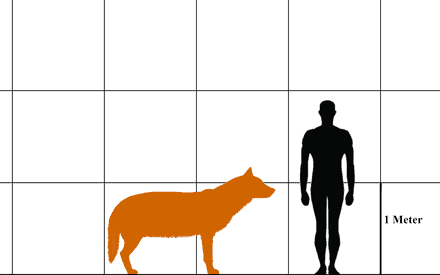
You may have seen them in Game of Thrones, but dire wolves (Canis dirus) were very much real creatures. The species roamed North America (and much less commonly, South America and Asia) during the Late Pleistocene for tens of thousands of years until it went extinct around 10,000 years ago, along with many other emblematic megafauna like the wooly mammoths or the saber-toothed cats.
It has since become an iconic prehistoric wildlife symbol and one of the most well-known extinct creatures from recent evolutionary history. Here are some things you may not have known about this extraordinary animal.
How is a dire wolf different from modern grey wolves?
The dire wolf was very similar in appearance to the grey wolf (Canis lupus), with the primary difference being that dire wolves were bulkier. Although their skeletal dimensions were very similar, the dire wolf was significantly heavier than the grey wolf. Paleontologists from Xavier University, Ohio estimated an average body mass of 60-68kg for the dire wolf, over 20 kg heavier than the grey wolf and making it the largest species of the subfamily Caninae.

Also unlike grey wolves, dire wolf fossil samples have rarely been found in high latitudes above 42°N, suggesting they were less fond of the cold. It is not yet known why the species was restricted the range this way, but proposed explanations include temperature and climate as well as prey availability. After the extinction of the dire wolves, grey wolves were able to move south into mid-continent North American territory, suggesting that competition with the dire wolves may have been restricting them to northern territories for thousands of years.
They last had a common ancestor with modern grey wolves 5.7 million years ago
Despite their name and similarity, dire wolves are actually less closely related to grey wolves than some other members of the canine family, such as the African wild dog and the Dhole. Researchers in 2021 used the DNA from five dire wolf samples that were dated from 12,900 to more than 50,000 years ago to determine the evolutionary history of the species. They found that dire wolves split from all other living canids around 5.7 million years ago.

ZME Science has previously reported on how this is likely an example of convergent evolution in action, showcasing how two evolutionarily distinct species can become superficially similar if they occupy similar ecological niches.
They likely did not compete for prey with sabretooth cats, despite what was once thought
In a 2019 study that analyzed fossils from Rancho La Brea in California, researchers found a substantial difference in the ecology of canid and felid predators. Specifically, the dire wolf was found to hunt in open environments, while saber-tooth cats such as Smilodon consumed prey from closed environments, suggesting that there was little competition between these two animals for prey.
The same researchers also analyzed tooth surfaces and found that their tooth complexity was very similar to the African wild dogs and extant coyotes. Consistent with prior research published in 2007, this suggests that dire wolves were adapted for both hunting live prey as well as scavenging carcasses.
The dire wolves and saber-toothed cats likely also displayed very different modes of hunting, analogous to modern dogs and cats. Dire wolves, similar to grey wolves, were pursuit predators with limbs adapted for fast running, while saber-toothed cats were likely ambush predators as modern big cats are as well.
They had the strongest bite force quotient of any placental mammal
It is not only its size and massive carnassial (shearing) teeth that made the dire wolf a formidable predator of its time. It also had an incredibly strong bite force – over twice as strong as the sabretooth cat (when body weight is controlled for).
Research published in 2005 showed that, after adjusting for body mass, the dire wolf outcompeted all other placental mammals in bite force, at 163 newtons/kilogram of body weight – compared to the grey wolf at 136. This incredible amount of force was likely due in large part to the large temporalis muscles on the side of its head.
However, several marsupial carnivores scored higher for bite force per body mass. Priscileo roskellyae and Thylacoleo carnifex are extinct marsupial lions from Australia that hold the record for all-time strongest mammalian bite force adjusted for body mass, while the Tasmanian devil has the highest bite force for body weight ratio of any living carnivorous mammal.

Comparisons of bite force quotients in mammalian predators – data from Wroe et al 2005
Dire wolves went extinct around 10,000 years ago – probably because its prey disappeared
The dire wolf relied on large herbivorous mammals to sustain itself – these included horses, giant sloths, and giant bison. During the extinction event, many of these larger mammals went extinct in what is known as the Late Pleistocene megafaunal extinction event. It is thought that the dire wolf was not able to survive on the smaller herbivores that survived the extinction event, whereas other smaller canids such as the grey wolf were able to.
In fact, new research has determined that a diet shift away from horses and towards moose and caribou was likely a key factor in grey wolves surviving the extinction event that saw the end of the dire wolves. Indeed, these prey species tend to be found in higher latitudes where grey wolves were typically present but dire wolves were rare, so it is possible that the distribution of these prey species may have been one reason why the grey wolves survived when dire wolves did not. However, this is only speculation and will require more research to conclude with any degree of certainty.
Dire wolves remain one of the iconic Pleistocene creatures, living alongside the early humans and fascinating our imagination for t thousands of years. As research continues to come in, we will no doubt learn even more about these wolves and the environment they lived in.


